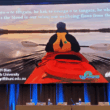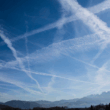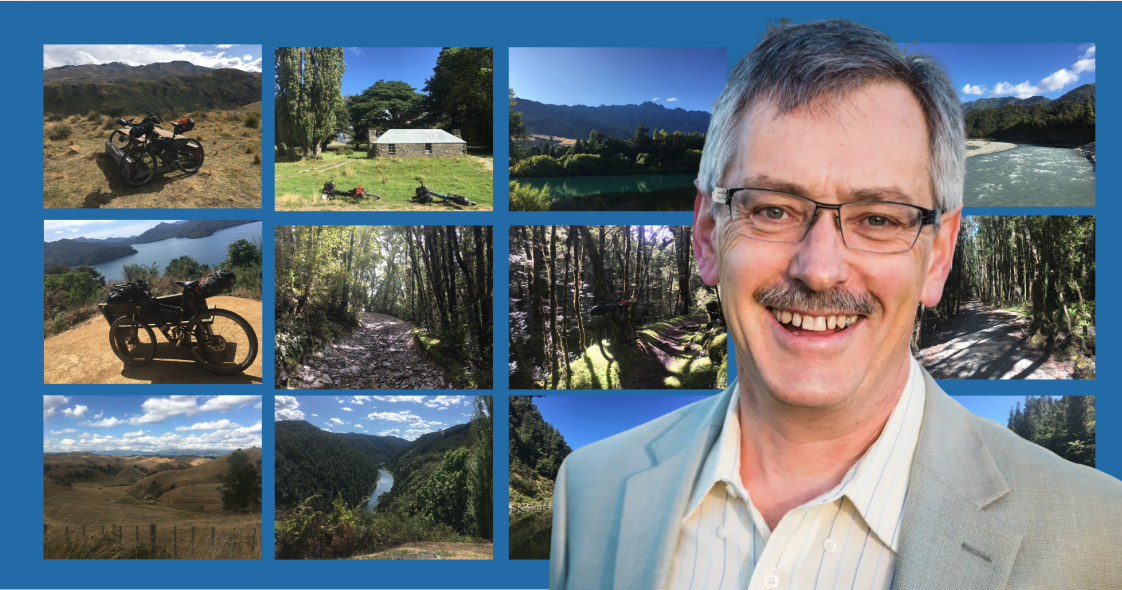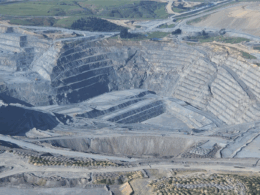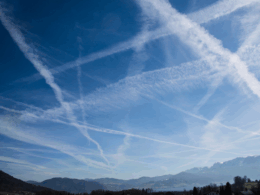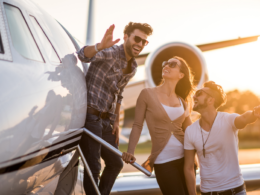How times have changed. In the 1990s New Zealand’s premier nature experiences included pulling over at roadside scenic lookouts or, for the more adventurous, tramping on the Great Walks. Now, welcome to the world of Te Araroa and not backpacking, but bikepacking.
[Image: Rod Oram pictured against a collage of photos taken by me on my TA bikepacking journey in 2020]
Transcript
When people in New Zealand mention the TA they probably think of Te Araroa (The Long Pathway) – New Zealand’s national trail – a long-distance hiking trail that connects Cape Reinga in the far north to Bluff at the bottom of the South Island. This 3000km trail traverses forests, mountains, and farmlands and passes through occasional towns and cities on its route. Walking the entire trail might take 4-6 months but Te Araroa can be done in sections. Unlike a Great Walk which may take three or four days, Te Araroa connects walkers to the whenua, to the landscapes and its communities, in the most immersive ways. As such, it offers rich opportunities for sustainable and regenerative tourism, and deeply embodied experiences.
****
And it turns out that there are deep domestic and international visitor markets that are interested in these sorts of deeply immersive adventure activities. Earlier this month, this point was brought into sharp focus in an article by Tsewang Nuru Sherpa that was published in The Press on 3 September. The article was titled ‘Aotearoa on two wheels: Inside New Zealand’s bikepacking boom’.
The article outlines that it is now possible to experience Aotearoa from end to end on two wheels rather than two feet. Yes, there is another TA – not Te Araroa but Tour Aotearoa. In February 2020 Newsroom’s weekly business, economics and politics columnist, the late Rod Oram wrote that “there’s nothing quite like an adventure to bring out the best in people”. He was writing based on personal experience. At the time Rod was writing his regular column for Newsroom while biking the length of the country from Cape Reinga to Bluff on the Tour Aotearoa trail.
Tour Aotearoa was created by the Kennett brothers. As Rod explained, the three Kennett brothers of Wellington are keen advocates for cycling in all of its forms from urban commuting to multi-day or weeks-long bikepacking adventures. They have been publishing cycling guides and books for several decades. Ten years ago they embarked on a project to chart a bike route the length of Aotearoa that connected the emerging networks of regional cycle trails. This network of trails had started to really expand at the time, driven by a supportive government that recognised the rich regional economic development opportunities associated with cycle trails. The ‘Tour Aotearoa’ was born – a national route of incredible cycle trails, connected where necessary by rural back roads (and as few main roads as possible). The inaugural biennial Tour Aotearoa took place in February-March 2016.
The philosophy underpinning the Tour Aotearoa is nicely explained by Rod Oram. He wrote in 2020 that three quintessentially Kiwi characteristics are particularly evident in this length of the country mountain biking adventure. The first is simplicity, yet sophistication. An event involving 1,200 cyclists over many weeks is immensely complicated. But the organisers – Jonathan, Paul and Simon Kennett, brought a simple sophistication to the enterprise through a clear division of labour. They are responsible for devising the route and managing the entries; while they leave each cyclist to organise themselves on the trail.
The brothers put a huge effort into creating the best route and documenting it in detail in their Tour guidebook. This includes useful information on campsites, shops and other amenities along the way. They produce route files for cycle computers and give frequent updates on the Tour’s Facebook page as road conditions or other factors change. They have also continually updated the route as new urban or rural cycle trails have developed and been added to the Tour Aotearoa to retire sections of road where cyclists may previously have had to interact with vehicles ranging from urban traffic or heavy logging trucks.
Like all astute social media influencers, the Kennett brothers don’t charge an entry fee. They ask only for proof of a rider’s $100 donation to a chosen charity and they ask riders to calculate and offset the carbon emissions they generate from their travel to the start of the ride at Cape Reinga and returning home after they finish the ride in Bluff. They provide riders with sample calculations for people in New Zealand and international riders coming from overseas, as well as recommended offset providers that are often linked to ecological restoration projects. Encouraged in this way, TA riders typically commit to fund raising for their chosen charity as part of their adventure.
The Kennett brothers have also kept the rules of the Tour very simple. It is a brevet, a French term for long distance cycling events that, in typical French style, only have a minimum and maximum completion timeframe. You must ride the 3,000km in no less than 10 days and no more than 30. Because some people do ride 300km or more a day, a second rule is you must not ride more than 18 hours a day. But the key point of a brevet is that you can cycle in your own way, at your own pace (averaging anything from 100km to 300km per day). It may be an entirely independent and unsupported if prepared to carry a tent and other equipment, or completed with elements of relative luxury by booking comfortable accommodation ahead of arrival at the end of each day of riding.
The third rule is that this is a biennial event. It has attracted some 1,200 riders, who leave Cape Reinga in waves of about 100 a day over many days over a three-week period. The staggered start is timed for an outgoing tide. The first leg includes 80km of 90 Mile beach on the day of departure from Cape Reinga, which is best ridden on a falling tide that leaves firm sand in the intertidal zone. As the Tour Aotearoa route has grown in interest, it has become a year-round activity that can be ridden independently of the biennial event, in sections or in its entirety, in either direction. But February, March and April are best for settled weather, even if the nights are getting colder in the Central North Island and lower South Island and the daylight hours a little shorter in the late summer.
****
Of course, the assets that underpins all of this are beautiful rural and remote New Zealand landscapes and the cycle trail network. After the GFC in 2008 and 2009 the John Key National government invested heavily in regional development and economic recovery through – among other things – investment in cycle trails. The Old Ghost Road is perhaps the most iconic of the trails developed through this regional investment. Following the success of the Central Otago Rail Trial, the Old Ghost Road became quickly established as a stunning biking trail that immediately demonstrated the regional economic value of cycle tourism. Cycling this old West Coast gold mining trail, with all its stories, has to be experienced to be believed. Or more conveniently, perhaps watch the ten minute video in the link provided at the end of the transcript. It is now part of an extensive cycle trail network that is the focus of global interest.
Since this time, and with the development of the Tour Aotearoa in 2016, bikepacking in New Zealand has experienced an enormous surge in popularity. This has inspired further regional trail development. The Southern Lakes Trail Trust is connecting the five Great Rides in Central Otago, forming over 500km of off-road cycle trails. This ongoing project includes over 32km in the Kawarau Gorge linking the Queenstown Twin Rivers Trail with the Lake Dunstan Trail at Cromwell. This will then connect to the Central Otago Rail trail, the stunning Roxburgh Gorge trail and the Clutha Gold trail that provides the link to coastal Otago. Similar networks are being further developed in the
North Island, including the Hangāruru Cycle Trail which opened three months ago, featuring two suspension bridges, and forming a vital piece of the vision to complete a 320km journey from Mt Ruapehu to the Tasman Sea in Whanganui.
****
Thebikepacking phenomenon in New Zealand, including events such as Tour Aotearoa, demonstrates a growing interest in adventure travel and a desire to experience the outdoors in a unique and challenging way. Although bikers ride at different speeds and with a wide range of motivations, this is a form of ‘slow travel’ where bikepackers seek sustainable and eco-friendly alternatives to the mainstream of tourism.
****
So what exactly are immersive experiences. Rod Oram provided fascinating insights in his weekly Newsroom column as he biked the third edition of Tour Aotearoa in February and March 2020. He noted that riders witness New Zealand’s environment and society close at hand every day and see many of the challenges facing New Zealand up close while cycling the length of the country.
He described Cape Reinga as a glorious and spiritual place to start the cycle journey. Brought to life by the local iwi Ngati Kuri the Guardians of Te Rerenga Wairua. Ngati Kuri have developed the spectacular Cape Reinga with information boards that explain to visitors its spiritual significance to Māori.
Riding south of 90 Mile Beach, it is evident that tourism is an area of fast growth for the far north, with plenty of signs of investment in new accommodation and attractions along the cycling route. The largest is the Manea – The Footprints of Kupe cultural heritage centre at Opononi on the Hokianga Harbour. It tells the story of the Polynesian navigator who brought the first people to Aotearoa, bringing a strong cultural dimension to our tourism to distinguish it in a crowded global market.
South of the spectacular Hokianga Harbour and through the Waipoua Forest, the kauri giants, Tane Mahuta being the most visible, remind visitors of the problem to Kauri dieback and their responsibilities to protect these sacred taonga.
The first three days of Rod’s cycle trip were through a hard drought in Northland. Given the scientific analysis, we know the local climate in Northland will only get hot and drier which will be a huge challenge to horticulture and agriculture in the region – this was particularly evident to cyclists riding through the parched far north landscapes, and the same in the Waikato and Manawatu farmlands.
At Poutu Point – the Kaipara Harbour crossing point – the nearby Wai Karetu Marae had open doors for cyclists to stay overnight if they missed the daily ferry to Helensville, providing first had experience of local manaakitanga. South of Auckland the Tour Aotearoa trail passes through Miranda where the hot pools, and the opportunity to experience the shorebird sanctuary provides insights into the importance of estuaries and coastal wetlands for migratory bird species.
Further south in the Waikato, after spending a night in Matamata, Rod dedicated a column to
The Maungatautari sanctuary. Maungatautari is one of the few untouched fragments of lowland native forest left in the Waikato. Almost the whole province was cleared of bush to make way for farms from the beginning in the 19th century.
Maungatautari is early example of how to protect, restore and regenerate. Some of the maunga was made a reserve as far back as the early 20th century, but restoration began in earnest in 2001 with the creation of the Maungatautari Ecological Island Trust. The plan to build a 47km predator proof fence to keep predators such as possums and rats out of the reserve seemed far-fetched at the time. As soon as the fence was finished, visitors could come and see the native forest regenerating. Progress has been spectacular since. Native trees and plants are thriving, as are native species of birds, bats, frogs, reptiles, tuatara and giant weta. Today, Maungatautari provides an insight into what the pre-human environment was like in Aotearoa.
The Tour Aotearoa follows the Waikato River Trail upstream alongside Lake Karāpiro, which was created by one of a series of hydro-electric dams built on the Waikato River before and after the Second World War. Here the trail passes the eight hydro dams along the Waikato River. The dams have drowned important cultural sites, changed the river’s ecology, and impacted on the relationship of iwi with the awa. However the dams have also contributed significantly New Zealand’s renewable energy supply.
Onward following the Timber Trail which traverses the Central North Island, including the geographic centre point of the North Island, many cyclists stay at the very remote Blue Duck Station in Whakahoro. Blue Duck Station is home to whio – hence the name – but also a range of other threatened native species including kiwi, pekapeka and karearea. Twenty years of pest control and planting over 120,000 native trees has restored unstable and unproductive farmland into thriving native bush and wetlands and a model of sustainable farming. Visitors and local communities are immersed and engaged to support pest control, tree planting & conservation in ways that embrace the Predator Free 2050 vision.
This is a very remote part of the central North Island. Beyond Whakahoro, the Upper Whanganui River valley is impassable without the support of a jet boat trip provided by a local iwi-owned company. The boat trip down the river provides vivid insights into the connection between the local iwi and the awa. The Jet boat trip from the ‘Bridge to Nowhere’ in the headwaters of the Whanganui to Pipiriki, provides the option of a fast ride or a more relaxed pace that is laced with rich local indigenous insights. Here, unlike the upper Waikato River, connection to the river remains intact and insights into the sacredness of the awa may be shared with visitors on the journey to the marae at Pipiriki.
These sorts of immersive experiences continue in the South Island. The Tour Aotearoa passes through old West Coast gold and coal mining towns. On the Big River Trail old gold mine sites remain cordoned off because they are still poisonously polluted; something that should not be forgotten when considering the Central Otago open cast mining proposal currently under fast-track review. Riders are encouraged to stop and pay respects at the Pike River Memorial Garden at Atarau – a sombre testament to the health and safety negligence that caused the Pike River mining disaster in November 2010, with the loss of 29 lives.
In Westland the Wilderness Trail traverses ancient rainforests, along rivers and heritage bridges that have been restored for the cycle trail, from Greymouth to Ross – another successful regional economic development initiative that has created local jobs while contributing to restoration rather than extraction of nature.
In stark contrast to the North Island drought, Rod explained the climate change modelling that shows a marked increase in rainfall and severity of storms on the West Coast. The ride south to the glaciers was full of evidence of severe storms including one that caused massive landslides that blocked Highway 6 north and south of Franz Josef and Fox townships, isolating them for some days. New Zealand defence personnel had erected in the matter of a few days an emergency bridge at Franz Josef to reconnect the town. Crews seemed to be working on securing landslips and maintaining the road on a permanent basis.
On the West Coast excavators also work at clearing alluvial deposits from riverbeds, deepening watercourses and strengthening stopbanks to try to make them more effective in storms. This was particularly evident south of Fox Glacier on Highway 6 where big excavators and loading trucks and trailers were busy at work. In Franz Josef enormous lateral stopbanks running along the river banks protect buildings that are below the ever rising level of the riverbed due to the powerful forces of erosion above the township. The original THC Hotel lies abandoned behind the stopbank, visibly below the level of the river, following repeated flood events. Rod explains that it is hard to not think that these efforts are so puny. When a powerful storm hits, it can move vast volumes of earth and rock, dramatically reshaping rivers and the surrounding land.
None of this is to mention that the iconic Westland glaciers are in sharp retreat. Perhaps the ultimate reminder of a changing climate and the need for tourism adaptation.
The West Coast is going to have to figure out far more fundamental ways to restore landscapes and ecosystems to make them more storm tolerant. But the challenge of adapting to climate change underway on the West Coast. Rod explained that a new generation of leaders are seeking to build a better future for the West Coast. These are people for whom deep sustainability in all senses of the word – environmental, economic, social and cultural – is critically important. In South Westland collaborative efforts are advancing Predator Free 2050 which is inspiring new forms of tourism that are integrated with ecological restoration and biodiversity.
In Central Otago the urgency of invasive conifer wilding pine control is evident along the cycle trails that follow the Hāwea, Clutha, Shotover and Kawarau rivers. As they traverse the stunning landscapes of Central Otago, cyclists can see firsthand the efforts of the Whakatipu Wilding Control Group volunteers, including Mana Tāhuna, and may contribute to the conservation work.
****
It is no surprise that the bikepacking trails included in the TA and others in New Zealand are attracting national and global interest. Trails like the Old Ghost Road and the Dunstan trail take riding to new levels of design, interpretation, and visitor immersion. The trails connect visitors with local residents, mana whenua, local conservation groups, ecological restoration projects and local businesses (like wineries, cafés, accommodation places, supermarkets and cycle shops among many others). In doing so, according to Tsewang Nuru Sherpa, these globally celebrated trails intertwine beautiful backcountry adventures with a spirit of camaraderie between visitors and local communities.
Bikepackers are unique. And their demographic has expanded considerably with the advent of electric bikes. They tend to be aware of climate change and how it is impacting regional communities, and committed to low carbon, slow tourism experiences. They tend to be committed to volunteering in local projects and keen to contribute to trail maintenance and local ecological restoration projects. They often have chosen charities that they actively raise funds for and donate to. They tend to enjoy meeting local people in local cafes and learn about what makes places and communities unique. They often want to see the world through local and indigenous eyes.
And they are very good for business. They eat more meals a day than is normal because of the active nature of their transport which comes with very high energy demands. Good local trails such and good national and regional trail networks such as the Tour Aotearoa are great for regional development through business opportunities, employment and local tourist expenditure. They are a driver of environmental protection, ecological restoration and connection between people and place. They leave the sustainable tourism cup overflowing.
So bravo to the cycle trail builders – they are the visionaries that are creating globally celebrated trails that are an asset for local communities, and for sustainable tourism, now and in the future.
This podcast episode is dedicated to the memory of Rod Oram.
References
- Te Araroa The Long Pathway (2025). https://www.teararoa.org.nz
- Tsewang Nuru Sherpa (2025). Aotearoa on two wheels: Inside NZ’s bikepacking boom. The Press. 3 September 2025. https://www.thepress.co.nz/travel/360759768/aotearoa-two-wheels-inside-nzs-bikepacking-boom
- Rod Oram (2020). Newsroom business, economics and politics columnist. https://newsroom.co.nz/author/rod-oram/page/21/
- The Old Ghost Road (2014). Official website. https://oldghostroad.org.nz
